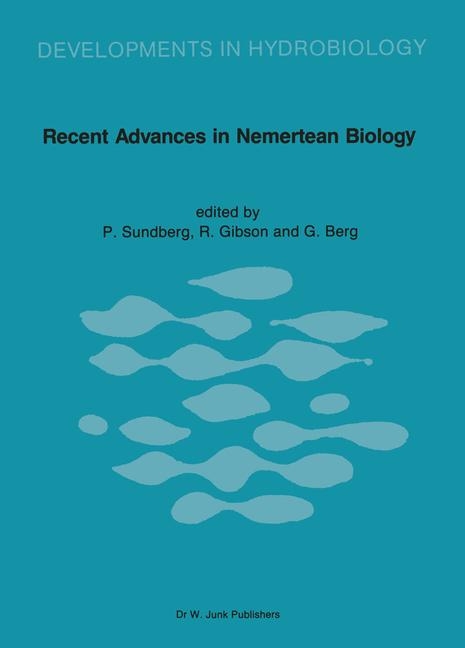
Recent Advances in Nemertean Biology
Springer (Verlag)
978-94-010-8304-1 (ISBN)
- Titel wird leider nicht erscheinen
- Artikel merken
The nemerteans are a fascinating, common and often locally abundant group of invertebrates, yet for long have attracted the attention of only a handful of scientists. In recent years, however, increasing numbers of people have developed diverse research interests in the group with the result that our knowledge of these worms has rapidly advanced. Clearly there is a need for a regular series of international meetings where individuals working on these animals can meet to exchange ideas, review developments concerning nemertean biology and freely discuss future proposals. The first such meeting was held in Philadelphia during December 1983. Twenty-seven scientists from eight countries participated in the Second International Meeting on Nemertean Biology, held at the Tjarno Marine Biological Laboratory, Sweden, 11-15 August 1986. The meeting was divid ed into five sessions: two dealt with ecological studies, two with nemertean taxonomy, and the final session covered aspects of general biology. A total of 26 papers was presented; four, by N. Anadem, G. Berg, 1. Bierne, and 1.M. TurbeviIIe, were for different reasons not submitted for inclusion in this volume. Three additional presentations were made on behalf of B. Kulikova, E. N. WiIImer, and Z. Yin, all of whom were unable to participate in the meeting.
One: Ecology.- 1. The role of hoplonemerteans in the ecology of seagrass communities.- 2. Ecological implications of the reproductive biology of symbiotic nemerteans.- 3. Diversity among nemertean egg predators of decapod crustaceans.- 4. Temporal variation in abundance of the egg predator Carcinonemertes epialti (Nemertea) and its effect on egg mortality of its host, the shore crab, Hemigrapsus oregonensis.- 5. Impact of the nemertean Lineus viridis on its polychaete prey on an intertidal sandflat.- 6. Food and feeding behavior of the hoplonemertean Oerstedia dorsalis.- 7. Neuroendocrine control of gonadogenesis in regenerating Lineus lacteus (Heteronemertea).- Two: Taxonomy and Phylogeny.- 8. Evolutionary relationships between mono- and polystiliferous hoplonemerteans: Nipponnemertes (Cratenemertidae), a "missing link" genus?.- 9. Marine relatives of terrestrial nemerteans: The genus Prosadenoporus Burger, 1890 (Hoplonemertea).- 10. Remarks on marine interstitial nemertines and key to the species.- 11. Polymorphism in Oerstedia dorsalis (Avilgaard, 1806) revisited: Electrophoretic evidence for a species complex.- 12. Hubrecht, Macfarlane, Jensen and Willmer: On the nature and testability of four versions of the nemertean theory of vertebrate origins.- 13. On the anatomy and taxonomy of Cerebratulus hepaticus Hubrecht, 1879 (Nemertini) from the Mediterranean (Banyuls-sur-Mer).- 14. On the hoplonemertean Sagaminemertes nagaiensis (Iwata, 1957), with consideration of its systematics.- 15. Notogaeanemertes folzae gen. n., sp. n., an additional ecologically restricted hoplonemertean from New Zealand.- Three: General Biology.- 16. Heavy metals in marine nemerteans.- 17. Pyridine alkaloid distribution in the hoplonemertines.- 18. Ecdysteroids in nemerteans: presence and physiological role.- 19. Water and solute regulation in Procephalothrix spiralis Coe and Clitellio arenarius (Muller). III. Long-term acclimation to diluted seawaters and effect of putative neuroendocrine structures.- 20. No direct contact between the excretory system and the circulatory system in Prostomatella arenicola Friedrich (Hoplonemertini).- 21. The colour pattern of Lineus atrocaeruleus (Nemertea).- 22. Oxytalan fibres in the epidermal basement membrane of Lineus atrocaeruleus (Nemertea).- Index of nomertean genera and species.- General index.
| Erscheinungsdatum | 19.12.2018 |
|---|---|
| Reihe/Serie | Developments in Hydrobiology ; 43 |
| Zusatzinfo | XII, 208 p. |
| Verlagsort | Dordrecht |
| Sprache | englisch |
| Maße | 216 x 280 mm |
| Themenwelt | Naturwissenschaften ► Biologie ► Limnologie / Meeresbiologie |
| Naturwissenschaften ► Biologie ► Ökologie / Naturschutz | |
| Schlagworte | anatomy • Biology • Ecology • Evolution • Systematics • Taxonomy |
| ISBN-10 | 94-010-8304-5 / 9401083045 |
| ISBN-13 | 978-94-010-8304-1 / 9789401083041 |
| Zustand | Neuware |
| Haben Sie eine Frage zum Produkt? |
aus dem Bereich


